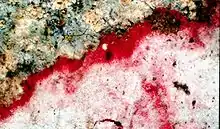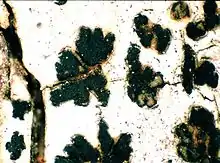Arthoniaceae
The Arthoniaceae are a family of lichenized, lichenicolous and saprobic fungi in the order Arthoniales.[1] The Arthoniaceae is the largest family of Arthoniales, with around 800 species.[2] Most genera in Arthoniaceae belong in Arthonia which is the largest genus with 500 species.[3] The second and third largest genus is Arthothelium with 80 species, and Cryptothecia with 60 species.[4]
| Arthoniaceae | |
|---|---|
 | |
| Cryptothecia rubrocincta, member of the Arthoniaceae | |
| Scientific classification | |
| Kingdom: | |
| Division: | |
| Class: | |
| Order: | |
| Family: | Arthoniaceae Rchb. (1841) |
| Type genus | |
| Arthonia Ach. (1806) | |
Arthonia is the type genus of Arthoniaceae, and it is known to be a polyphyletic and paraphyletic genus.[5] The process of splitting Arthonia into monophyletic groups is an ongoing process. In order to make Arthonia monophyletic, several genera have been described or resurrected.[6]
Distribution
The species in Arthoniaceae have a worldwide distribution, but are especially prevalent in tropical areas with a Mediterranean climate.[1] They are known from arctic to tropical latitudes, as well as variating altitudes from sea level to alpine regions, distributed in both humid forests and dry habitats.[6]
Ecology
Collectively, the family have a highly variable ecology with lichenized, lichenicolous and saprobic fungi.[1] The majority of species is lichenized with a photobiont from Trentepohliaceae and a few species in Arthonia is lichenized with a photobiont from Chlorococcaleae. They grow on leaves, bark, bryophytes and living leaves and rocks.[7] Other species are lichenicolous—growing on other lichens and a few species are known to be saprobic.[4]
History
The family was first described by Heinrich Gottlieb Ludwig Reichenbach in 1841.[1]
Genera
- Amazonomyces
- Arthonia
- Arthothelium
- Bryostigma
- Coniangium
- Coniarthonia
- Coniocarpon
- Crypthonia
- Cryptophaea
- Cryptothecia
- Eremothecella
- Felipes
- Glomerulophoron
- Herpothallon
- Inoderma
- Leprantha
- Melarthonis
- Myriostigma
- Pachnolepia
- Paradoxomyces
- Reichlingia
- Sporodophoron
- Stirtonia
- Tylophoron [6][8]
References
- Encyclopedia of Life, consulted at september the seventeenth 2013
- Sundin, Rikard; Thor, Göran; Frisch, Andreas (2012-01-01). "A literature review of Arthonia s. lat". Biblioth. Lichenol. 108: 257–290.
- Grube, M. "A taxonomic survey of arthonioid fungi with reddish K+ reactive pigments". Doctoral Dissertation, Karl-Franzens-Universität, Graz.
- "The Lichens of Great Britain and Ireland". www.nhbs.com. Retrieved 2018-03-14.
- Sundin, Rikard; Tehler, Anders (July 1998). "Phylogenetic Studies of the Genus Arthonia". The Lichenologist. 30 (4–5): 381–413. doi:10.1006/lich.1998.0155. ISSN 1096-1135.
- Frisch, Andreas; Thor, Göran; Ertz, Damien; Grube, Martin (2014-08-28). "The Arthonialean challenge: Restructuring Arthoniaceae". Taxon. 63 (4): 727–744. doi:10.12705/634.20.
- Cannon PF, Kirk PM (2007). Fungal Families of the World. Wallingford, UK: CAB International. pp. 17–18. ISBN 978-0-85199-827-5.
- Wijayawardene, Nalin N.; Hyde, Kevin D.; Lumbsch, H. Thorsten; Liu, Jian Kui; Maharachchikumbura, Sajeewa S. N.; Ekanayaka, Anusha H.; Tian, Qing; Phookamsak, Rungtiwa (2018-01-01). "Outline of Ascomycota: 2017". Fungal Diversity. 88 (1): 167–263. doi:10.1007/s13225-018-0394-8. ISSN 1560-2745.
| Wikimedia Commons has media related to Arthoniaceae. |
